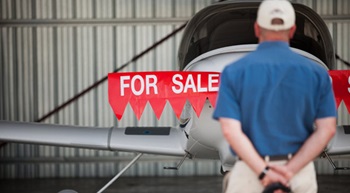 Everybody likes shopping for a new airplane! Whether it’s an enticing stroll through an aircraft display at an airshow or scouring the classifieds for aircraft in your price range, it’s exciting to consider the expanded options a different aircraft could offer. But, behind every airplane for sale is, of course, its seller, hoping to connect with a qualified buyer. If you are the one standing next to the "Aircraft for Sale" sign, this article is for you.
Everybody likes shopping for a new airplane! Whether it’s an enticing stroll through an aircraft display at an airshow or scouring the classifieds for aircraft in your price range, it’s exciting to consider the expanded options a different aircraft could offer. But, behind every airplane for sale is, of course, its seller, hoping to connect with a qualified buyer. If you are the one standing next to the "Aircraft for Sale" sign, this article is for you.
Once you’ve shined up your airplane, made sure all maintenance, inspections, and logbooks are up to date, and advertised it through various outlets, refresh your knowledge about the buying and selling process. Here are some tips to help the process proceed smoothly.
Paperwork
You, the seller, are the one to complete a bill of sale (preferably the standard FAA form, currently Form 8050-2, available from AOPA, most FAA FSDO offices, or a dealer at your nearest airport). Although the standard form is not required, it is highly recommended. Make sure your name is written on the bill of sale exactly as it is on the registration – they have to match. An original signature is required on both copies of the 8050-2. Both copies go to the buyer – one copy will be paired with the registration application to go to the FAA, so make yourself an additional copy if you want one. In the event you can’t obtain an original bill of sale, you can use a faxed or photocopied form if – and only if – there are original signatures on both copies.
Aircraft Transfer
The aircraft transfer occurs when the bill of sale is signed. To ensure a smooth transfer, be sure the form of payment is truly legitimate. A certified or cashier’s check from a bank is a common mode of payment, but be cautious as there are occasional check scams. A safer choice might be a bank wire transfer. Better yet, consider using an escrow service, which can both simplify the process and protect both parties. We recommend our strategic partner: Aircraft Title and Escrow Services provided by Aero-Space Reports to handle the transfer of funds.
If you are working through a broker or a dealer, make sure your written agreement clearly requires that the buyer pay you directly; then you pay the broker afterward.
Your insurance on the aircraft may terminate with the completed bill of sale transfer, depending on how your policy is written.
Before you hand over the bill of sale and the keys, remove the original aircraft registration certificate, with your name on it, from the aircraft. Complete the sale information on the back of that certificate and mail it to the FAA registry in Oklahoma City. If there is an FCC radio station license with your name on it, remove that, as well. Provide all logbooks and records on the aircraft (as agreed upon) to the buyer. If you know the buyer is a foreign national and the N-number cannot be maintained, you are required to remove the N-number. You can paint it over or strip it off, as long as it is removed.
If you have questions about buying or selling aircraft, or any other aviation-related topic, call the aviation experts in AOPA’s Pilot Information Center, Monday through Friday, 8:30 a.m. to 6 p.m. Eastern Time, 800-USA-AOPA (872-2672).


